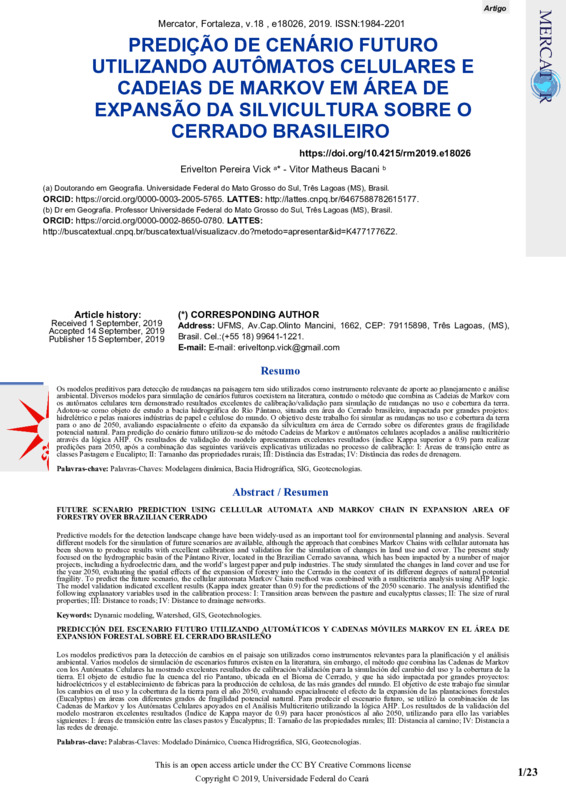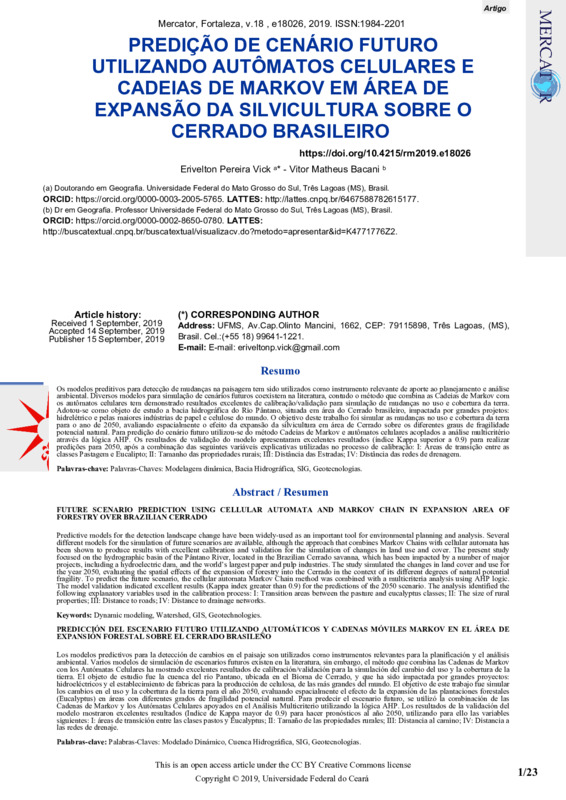PREDIÇÃO DE CENÁRIO FUTURO UTILIZANDO AUTÔMATOS CELULARES E CADEIAS DE MARKOV EM ÁREA DE EXPANSÃO DA SILVICULTURA SOBRE O CERRADO BRASILEIRO
Item
-
Título
-
PREDIÇÃO DE CENÁRIO FUTURO UTILIZANDO AUTÔMATOS CELULARES E CADEIAS DE MARKOV EM ÁREA DE EXPANSÃO DA SILVICULTURA SOBRE O CERRADO BRASILEIRO
-
Mercator
-
Universidade Federal do Mato Grosso do Sul
-
Universidade Federal do Mato Grosso do Sul
-
Autor
-
Vitor Matheus Bacani
-
Erivelton Pereira Vick
-
Assunto
-
Bacia Hidrográfica
-
Geotecnologias
-
Modelagem dinâmica
-
SIG
-
Abstract
-
Predictive models for the detection landscape change have been widely-used as an important tool for environmental planning and analysis. Several different models for the simulation of future scenarios are available, although the approach that combines Markov Chains with cellular automata has been shown to produce results with excellent calibration and validation for the simulation of changes in land use and cover. The present study focused on thehydrographic basin of the Pântano River, located in the Brazilian Cerrado savanna, which has been impacted by a number of major projects, including a hydroelectric dam, and the world’s largest paper and pulp industries. The study simulated the changes in land cover and use for the year 2050, evaluating the spatial effects of the expansion of forestry into the Cerrado in the context of its different degrees of natural potential fragility. To predict the future scenario, the cellular automata Markov Chain method was combined with a multicriteria analysis using AHP logic. The model validation indicated excellent results (Kappa index greater than 0.9) for the predictions of the 2050 scenario. The analysis identified the following explanatory variables used in the calibration process: I: Transition areas between the pasture and eucalyptus classes; II: The size of rural properties; III: Distance to roads; IV: Distance to
drainage networks. The model revealed a strong overall tendency for the substitution of livestock by forestry by 2050, with a predominance of expansion into areas of medium environmental fragility.Keywords: Dynamic modeling, Watershed, GIS, Geotechnologies.
-
volume
-
18
-
Date
-
2019
-
Língua
-
en-US
-
doi
-
10.4215/rm2019.e18026
-
issn
-
1984-2201



